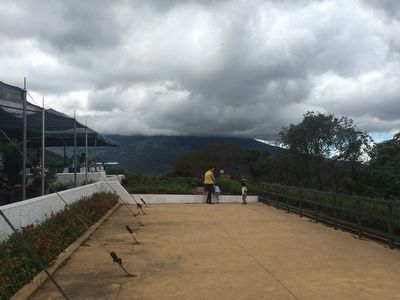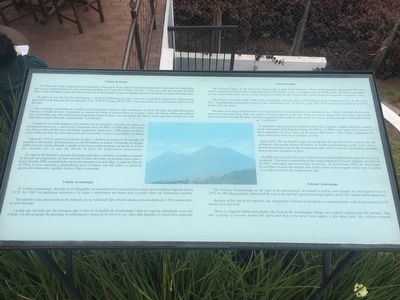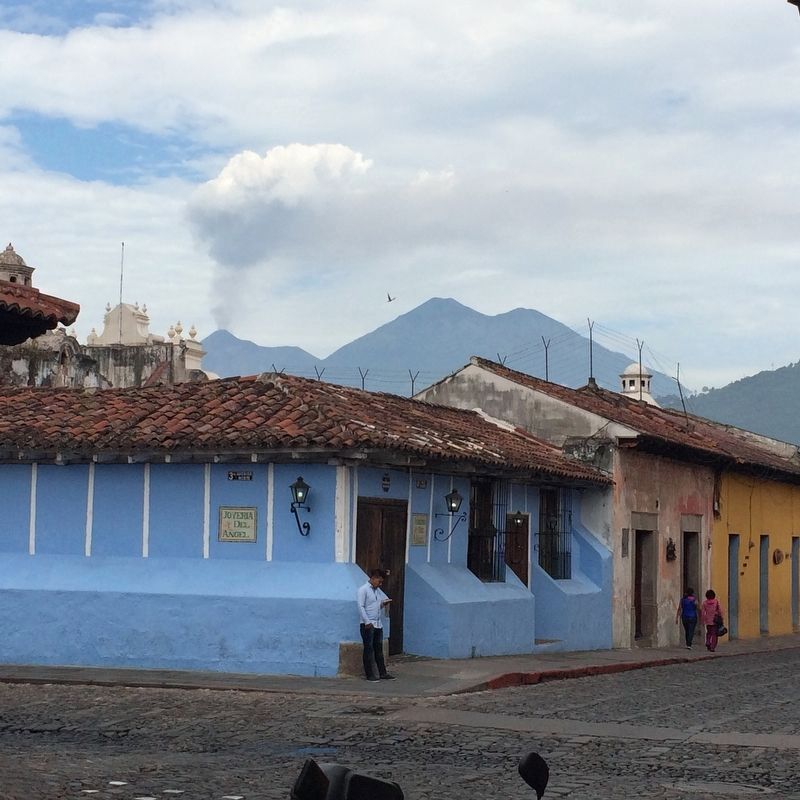Antigua Guatemala, Sacatepéquez, Guatemala — Central America (Central Highlands)
Volcanos Fuego and Acatenango
Se ubica al sur del Volcán Acatenango y dista 45 kilómetros en línea recta de la ciudad de Guatemala. Su posición geográfico está dada por las coordenadas: Lat. 14°28.9’N; long. 90°52.9’W y tiene una altura de 3,763 metros sobre el nivel del mar.
Por su forma y estructura se clasifica como un estrato-volcán o cono compuesto, es decir, formado por capas alternas de escoria y coladas de lava. Solamente se conoce un cráter, el cual se ubica en su cima. Tiene una forma cónica con laderas muy inclinadas que descienden uniformamente hasta la base, con excepción del flanco norte que está cortado por una estructura antigua llamada comúnmente “La Meseta”.
Constituye el centro eruptivo más reciente de un complejo volcánico que tiene una orientación norte-sur y que inició a formarse hace 84,000 a 43,000 años. Por todos sus flancos está cubierto por una densa vegetación, hasta unos 3,000 metros de altura, y por arriba de ésta, ha sido removida por la erosión y/o por la actividad volcánica.
Antes de 1932 la cima tenía forma de pico y durante la erupción de ese año, la cúspide se derrumbó, disminuyendo en casi 80 metros su altura y formando un amplio cráter con una cresta dentada y aguda en la mayor parte noreste, en donde se formó una brecha por la que ha fluido la lava de erupciones posteriores.
El cráter se ha llenado y vaciado de manera periódica, conforme se produce el aporte de lava de las erupciones. El más reciente llenado del cráter se produjo entre enero y marzo del año 2002, coincidiendo con un incremento en la actividad. A partir de febrero de 2002, la lava comenzó a desbordarse hacia el flanco este del cráter y a partir de agosto del mismo año, también hacia el flanco suroreste (sic, sureste).
De acuerdo a las características de erupción, es un volcán de tipo estratovolcano con una altura de 1,976 metros sobre

Photographed By J. Makali Bruton, December 19, 2015
2. Volcanos Fuego and Acatenango Marker
Unfortunately clouds cover the Volcano Agua in the distance. The Volcanos Fuego and Acatenango are to the right in this image. The marker can be seen in the distance to the left, with the Volcano Agua marker on its left.
Cuenta una leyenda que las personas que vivían en el pueblo de Acatenango veían un espíritu caminando cerca del volcán. Un día un grupo de personas lo molestaron y nunca se le volvió a ver; unos días después el volcán hizo erupción.
The Fuego is located to the south of the Acatenango volcano and is 45 kilometers from Guatemala City, as the crow flies. Its geographical position is given by the coordinates: Lat. 14°28.9’N; long. 90°52.9’W and it has an altitude of 3,763 meters over sea level.
Because of its shape and structure, it is classified as a stratovolcano or compound cone. That is, formed of alternate layers of scoria and lava. Only one crater is known, located at the top. It has a conical shape with very steep slopes that descend evenly towards the base, with the exception of the northern side, where it is cut by an old structure commonly known as “La Meseta”.
It constitutes the most recent eruptive center
of a volcanic complex that has a north-south orientation and began forming 84,000 to 43,000 years ago. It is covered by thick vegetation on all its sides, up to about 3,000 meters. Above that, vegetation has been removed by erosion or volcanic activity.
Before 1932, the top had the shape of a peak but, during that year’s eruption, the top collapsed, decreasing almost 80 meters in height and forming a wide crater with a dented and pointed crest on the northeastern side, where a breccia was formed allowing lava from later eruptions to flow.
On different occasions the crater has been periodically filled and emptied, as lava is produced. The most recent filling of the crater happened between January and March of 2002, coinciding with an increase in activity. As of February 2002, the lava began to overflow towards the eastern side of the crater and in August of that year it started to overflow towards the southeastern side.
Because of the type of its eruptions, the Acatenango Volcano is classified as a stratovolcano, with an elevation of 3,976 meters over sea level.
There is a legend telling that people who lived in the Acatenango village saw a spirit walking near the volcano. One day a group of persons teased the spirit and they were never seen again; a few days later, the volcano erupted.
Topics. This historical marker is listed in these topic lists: Disasters • Science & Medicine. A significant historical month for this entry is February 2002.
Location. 14° 33.155′ N, 90° 43.374′ W. Marker is in Antigua Guatemala, Sacatepéquez. The marker is in the outdoor seating area for the El Tenedor restaurant on Cerro Santo Domingo. The Cerro Santo Domingo is reached from an unnamed cobblestone street on the right after the Shell Gas Station when leaving Antigua Guatemala on Calle de Chipilapa towards Guatemala City. Touch for map. Marker is in this post office area: Antigua Guatemala, Sacatepéquez 03001, Guatemala. Touch for directions.
Other nearby markers. At least 8 other markers are within walking distance of this marker. Volcano Agua (here, next to this marker); Catholic Church of Santa Ana (approx. 0.6 kilometers away); Home of Brother Pedro (approx. 0.6 kilometers away); Pedro Cofiño and Ramon Palencia Shot by Firing Squad (approx. 0.7 kilometers away); Las Delicias Fountain (approx. 0.7 kilometers away); Friar Augusto Ramírez Monasterio (approx. 0.8 kilometers away); Don Rafael V. Alvarez Polanco (approx. 0.8 kilometers away); J. Adrian Coronado y Polanco (approx. 0.8 kilometers away). Touch for a list and map of all markers in Antigua Guatemala.
Credits. This page was last revised on March 2, 2018. It was originally submitted on February 14, 2016, by J. Makali Bruton of Accra, Ghana. This page has been viewed 480 times since then and 9 times this year. Photos: 1, 2. submitted on February 14, 2016, by J. Makali Bruton of Accra, Ghana. 3. submitted on July 6, 2017, by J. Makali Bruton of Accra, Ghana.

